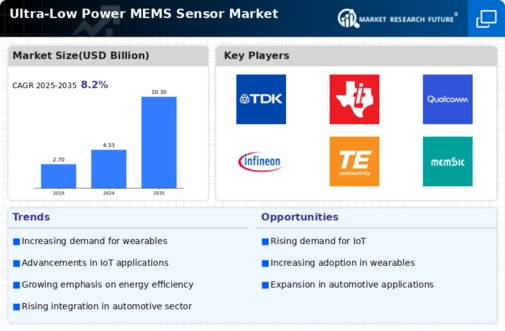The drivers of the Ultra-Low Power MEMS Sensor Market include the increased need for power-efficient options in consumer electronics, healthcare, automotive, IoT – and other industries. Devices need to have a small footprint in terms of power consumption while having a good overall performance. This acceleration of the trend is owing to the switch to automation and smart devices whereby manufacturers want to improve the overall user experience and still minimize energy usage. Additionally, advancements in sensor technology are important, too, since they provide features such as better performance and more reliability but consume less power.
The Ultra-Low Power MEMS sensor market has a bright future with advances in wireless communication technologies and the continued growth of smart cities. As industries develop IoT infrastructure, the demand for innovative and versatile sensors presents an opportunity for companies to take advantage of new markets. Further, developing countries with higher disposable incomes are expected to embrace such technologies, opening new avenues for businesses. Partnerships of tech firms with start-ups could result in revolutionary inventions, which focus on novel sensor applications in various fields.
The recent observations are also pointing towards increasing applications of AI technologies with sensors for more intelligent data processing and decision-making capacity.
The Ultra Low Power MEMS Sensor Market is primarily driven by the growing demand for energy-efficient solutions across various applications, including consumer electronics, healthcare, automotive, and the Internet of Things (IoT). As devices become smarter and more connected, the need for sensors that consume minimal power while delivering high performance is crucial. The shift towards automation and smart devices is further bolstering this trend, as manufacturers seek to enhance user experience without compromising on energy consumption. Innovations in sensor technology also play a significant role, offering capabilities like improved accuracy and reliability while maintaining low power usage.
Opportunities in the ultra low power MEMS sensor market are ripe, especially with advancements in wireless communication technologies and the continued expansion of smart cities. As industries invest in IoT infrastructure, the need for adaptive and efficient sensors presents a chance for companies to capitalize on new applications. Moreover, emerging markets with increasing disposable income are likely to adopt these technologies, allowing businesses to explore untapped potential. Collaborations between technology companies and startups could lead to groundbreaking developments, emphasizing creative sensor applications in diverse fields.
Recent trends indicate a surge in the integration of artificial intelligence with sensor technology, allowing for smarter data processing and decision-making. This integration supports the growth of autonomous systems, which require real-time data analysis while keeping energy consumption to a minimum. Additionally, sustainability concerns are driving innovation, with manufacturers focusing on green technologies and recyclable materials. As research continues to advance, the scope for Ultra-Low Power MEMS sensors will expand, paving the way for future developments that enhance both functionality and environmental compatibility.
Overall, the landscape for Ultra-Low Power MEMS sensors is evolving, highlighting the importance of collaboration, innovation, and market responsiveness in a rapidly changing environment.
The increasing demand for energy-efficient devices is driving innovation in the Ultra-Low Power MEMS Sensor market, as these sensors are poised to play a crucial role in the advancement of smart technologies across various sectors.
U.S. Department of Energy























Leave a Comment